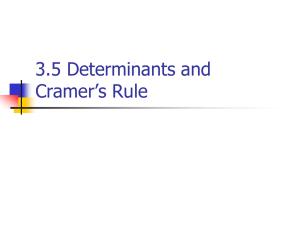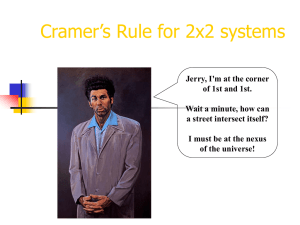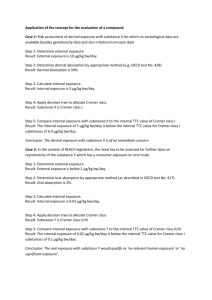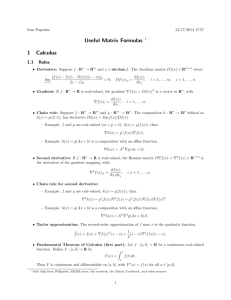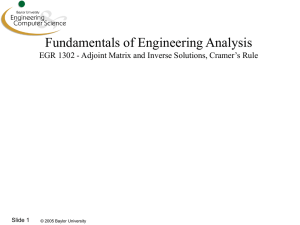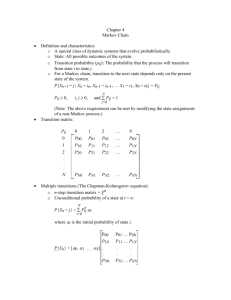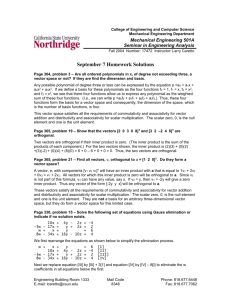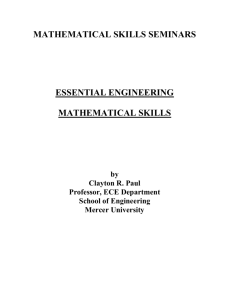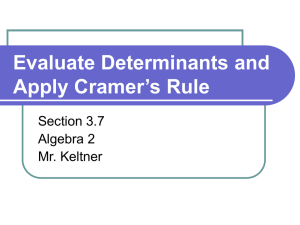Cramer`s Rule
advertisement
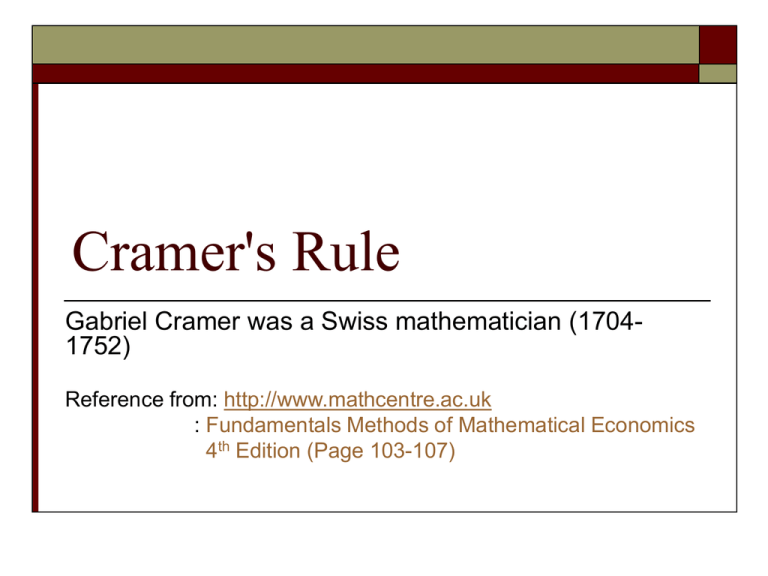
Cramer's Rule Gabriel Cramer was a Swiss mathematician (17041752) Reference from: http://www.mathcentre.ac.uk : Fundamentals Methods of Mathematical Economics 4th Edition (Page 103-107) Introduction Cramer’s Rule is a method for solving linear simultaneous equations. It makes use of determinants and so a knowledge of these is necessary before proceeding. Cramer’s Rule relies on determinants Coefficient Matrices You can use determinants to solve a system of linear equations. You use the coefficient matrix of the linear system. Linear System Coeff Matrix ax+by=e a b c d cx+dy=f Cramer’s Rule for 2x2 System Let A be the coefficient matrix Linear System Coeff Matrix ax+by=e a b = ad – bc cx+dy=f c d If detA 0, then the system has exactly one solution: e b f d x det A and a e c f y det A Key Points The denominator consists of the coefficients of variables (x in the first column, and y in the second column). The numerator is the same as the denominator, with the constants replacing the coefficients of the variable for which you are solving. Example - Applying Cramer’s Rule on a System of Two Equations Solve the system: 8x+5y= 2 2x-4y= -10 The coefficient matrix is: So: 8 5 2 4 2 5 10 4 x 42 and and 8 5 2 4 (32) (10) 42 8 2 2 10 y 42 2 5 10 4 8 (50) 42 x 1 42 42 42 8 2 2 10 80 4 84 y 2 42 42 42 Solution: (-1,2) Applying Cramer’s Rule on a System of Two Equations ax by e cx dy f D a b c d e Dx f b d a e c f Dy Dy Dx x y D D 2 x 3 y 16 3x 5 y 14 2 3 D (2)(5) (3)(3) 10 9 19 3 5 16 3 Dx (16)(5) (3)(14) 80 42 38 14 5 2 16 Dy (2)(14) (3)(16) 28 48 76 3 14 Dy 76 Dx 38 x 2 y 4 D 19 D 19 Evaluating a 3x3 Determinant (expanding along the top row) Expanding by Minors (little 2x2 determinants) a1 b1 c1 a2 b2 c2 a1 a3 b3 c3 b2 c2 b3 c3 b1 a2 c2 a3 c3 c1 a2 b2 a3 b3 1 3 2 2 0 1 2 0 3 2 3 2 0 3 (1) (3) (2) 2 3 1 3 1 2 3 (1)(6) (3)(3) ( 2)(4) 6 9 8 23 Using Cramer’s Rule to Solve a System of Three Equations Consider the following set of linear equations a11 x1 a12 x2 a13 x3 b1 a21 x1 a22 x2 a23 x3 b2 a31 x1 a32 x2 a33 x3 b3 Using Cramer’s Rule to Solve a System of Three Equations The system of equations above can be written in a matrix form as: a11 a 21 a31 a12 a22 a32 a13 x1 b1 a23 x2 b2 a33 x3 b3 Using Cramer’s Rule to Solve a System of Three Equations Define a11 a12 a13 a A a a 21 22 23 a31 a32 a33 x1 b1 x x2 and B b2 x3 b3 If D 0,thenthesystemhasauniquesolution asshownbelow(Cramer'sRule). D3 D1 D2 x1 , x2 , x3 D D D Using Cramer’s Rule to Solve a System of Three Equations where a11 a12 a13 b1 a12 D a12 a22 a23 D1 b2 a22 a13 a32 a11 b1 D2 a12 b2 a13 b3 a33 b3 a32 a13 a23 a33 a13 a11 a12 b1 a23 D3 a12 a22 b2 a33 a13 a32 b3 Example 1 Consider the following equations: 2 x1 4 x2 5 x3 36 3 x1 5 x2 7 x3 7 5 x1 3x2 8 x3 31 A x B where 2 4 5 A 3 5 7 5 3 8 Example 1 x1 36 x x2 and B 7 x3 31 2 4 5 D 3 5 5 3 7 336 8 36 4 5 D1 7 5 7 672 3 8 31 Example 1 2 36 5 D2 3 7 7 1008 5 31 8 2 4 36 D3 3 5 5 3 7 1344 31 D1 672 x1 2 D 336 D 1008 x2 2 3 D 336 D3 1344 x3 4 D 336 Cramer’s Rule - 3 x 3 Consider the 3 equation system below with variables x, y and z: a1 x b1 y c1z C1 a2 x b2 y c2 z C2 a3 x b3 y c3z C3 Cramer’s Rule - 3 x 3 The formulae for the values of x, y and z are shown below. Notice that all three have the same denominator. C1 b1 c1 C2 b2 c2 C3 b3 c3 x a1 b1 c1 a2 b2 c2 a3 b3 c3 a1 C1 c1 a2 C2 c2 a 3 C 3 c3 y a1 b1 c1 a2 b2 c2 a3 b3 c3 a1 b1 C1 a2 b2 C2 a3 b3 C3 z a1 b1 c1 a2 b2 c2 a3 b3 c3 Example 1 Solve the system : 9 5 2 x 3 1 1 2 2 1 2 2 1 1 2 4 23 1 1 23 2 4 3x - 2y + z = 9 x + 2y - 2z = -5 x + y - 4z = -2 3 9 1 1 5 2 1 2 4 69 y 3 3 2 1 23 1 2 2 1 1 4 Example 1 3 2 9 1 2 5 1 1 2 0 z 0 3 2 1 23 1 2 2 1 1 4 The solution is (1, -3, 0) Cramer’s Rule Not all systems have a definite solution. If the determinant of the coefficient matrix is zero, a solution cannot be found using Cramer’s Rule because of division by zero. When the solution cannot be determined, one of two conditions exists: The planes graphed by each equation are parallel and there are no solutions. The three planes share one line (like three pages of a book share the same spine) or represent the same plane, in which case there are infinite solutions.
